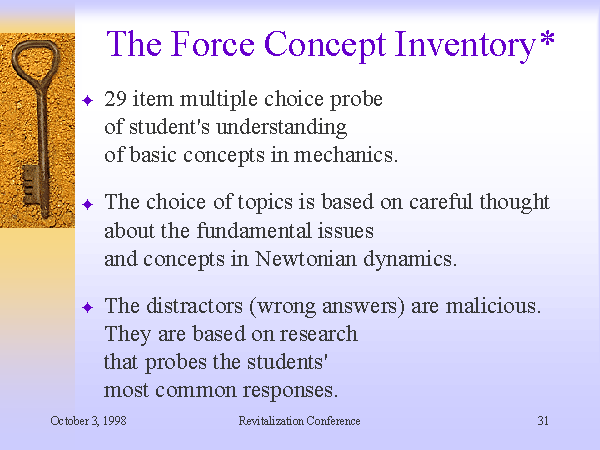wikipedia | A concept inventory is a criterion-referenced test designed to evaluate whether a student has an accurate working knowledge
of a specific set of concepts. To ensure interpretability, it is common
to have multiple items that address a single idea. Typically, concept
inventories are organized as multiple-choice tests
in order to ensure that they are scored in a reproducible manner, a
feature that also facilitates administration in large classes. Unlike a
typical, teacher-made multiple-choice test, questions and response
choices on concept inventories are the subject of extensive research.
The aims of the research include ascertaining (a) the range of what
individuals think a particular question is asking and (b) the most
common responses to the questions. Concept inventories are evaluated to
ensure test reliability and validity.
In its final form, each question includes one correct answer and
several distractors. The distractors are incorrect answers that are
usually (but not always) based on students' commonly held
misconceptions.[1]
Ideally, a score on a criterion-referenced test reflects the amount
of content knowledge a student has mastered. Criterion-referenced tests
differ from norm-referenced tests
in that (in theory) the former is not used to compare an individual's
score to the scores of the group. Ordinarily, the purpose of a
criterion-referenced test is to ascertain whether a student mastered a
predetermined amount of content knowledge; upon obtaining a test score
that is at or above a cutoff score,
the student can move on to study a body of content knowledge that
follows next in a learning sequence. In general, item difficulty values
ranging between 30% and 70% are best able to provide information about
student understanding.
Distractors are often based on ideas commonly held by students, as
determined by years of research on misconceptions. Test developers often
research student misconceptions by examining students' responses to
open-ended essay questions and conducting "think-aloud" interviews with
students. The distractors chosen by students help researchers understand
student thinking and give instructors insights into students' prior
knowledge (and, sometimes, firmly held beliefs). This foundation in
research underlies instrument construction and design, and plays a role
in helping educators obtain clues about students' ideas, scientific misconceptions, and didaskalogenic, that is, teacher-induced confusions and conceptual lacunae that interfere with learning.



2 comments:
ok, mebbe five or six....,
planned obsolescence, double-entry accounting, north tower, great books, bad economics, cornerstones of white supremacy...,
(though it's always perplexed me a little bit how the great books can emerge from an otherwise evil and suspect system of production)
"though it's always perplexed me a little bit how the great books can
emerge from an otherwise evil and suspect system of production"
There are always outliers. Sometimes they can be recognized by how much they are attacked. More often their works just disappear while material that supports the status quo gets promoted and shoved in everyone's face.
An example of this is the video series "The Age of Uncertainty" by John Kenneth Galbraith. I noticed this because it came on television the year after I noticed economists ignored Demand Side Depreciation. But then Milton Friedman came out with his "Free to Choose" series. I watched both of them. Galbraith blew Friedman away JKG was informative enough to make thinking possible while Friedman was just a propagandist. But when YouTube started it was Milton's stuff that showed up.all of the time.
AoU first turned up in Oct of 2009.
But I am sure that creating tests which measure understanding rather than mere memorization must be difficult.
Post a Comment